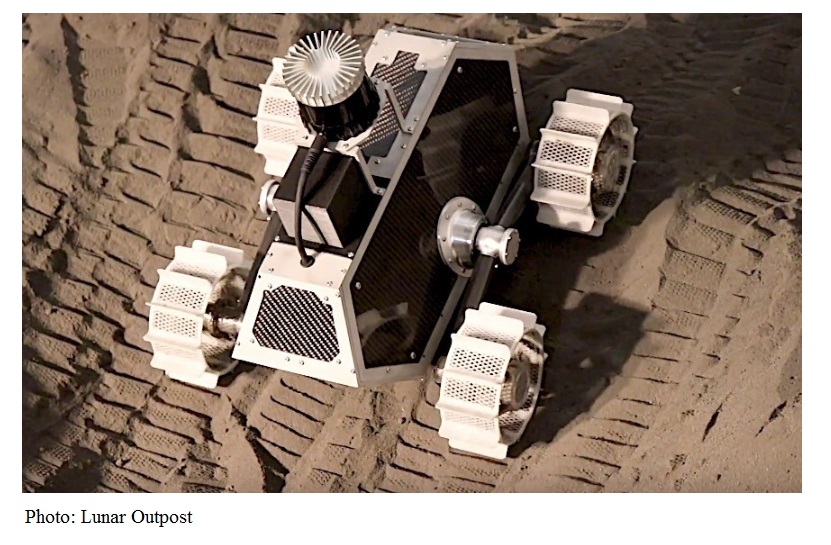November 14, 2018
Lunar Outpost, a space technology startup developing enabling technologies for a sustained presence on the Lunar surface, announced their Lunar Prospector designed to search for and map the Moon’s natural resources. The first Prospector was demonstrated driving and drilling in Lunar regolith simulant at the Colorado School of Mines' new Lunar testbed facility in the Earth Mechanics Institute overseen by the Center for Space Resources. This event marks the first commercial Lunar Prospector publicly tested in the United States.
 Evidence of valuable resources on the Lunar surface, such as water, precious metals, and helium-3 have been established by remote sensing on flyby missions around the Moon. This scientific data has been used to create general resource models of the Lunar surface, which now require ground-truthing to establish optimal landing sites and plan future resource extraction operations. Groups of Lunar Outpost Prospectors will map the surface and subsurface resources of the Moon, while autonomously navigating along waypoints and avoiding hazards such as large rocks and craters. These Prospectors can also be teleoperated if needed and can utilize NASA’s Lunar Orbital Platform-Gateway concept as a center of operations.
Evidence of valuable resources on the Lunar surface, such as water, precious metals, and helium-3 have been established by remote sensing on flyby missions around the Moon. This scientific data has been used to create general resource models of the Lunar surface, which now require ground-truthing to establish optimal landing sites and plan future resource extraction operations. Groups of Lunar Outpost Prospectors will map the surface and subsurface resources of the Moon, while autonomously navigating along waypoints and avoiding hazards such as large rocks and craters. These Prospectors can also be teleoperated if needed and can utilize NASA’s Lunar Orbital Platform-Gateway concept as a center of operations.
The Lunar Outpost Prospectors are focused on providing exploration data for In-Situ Resource Utilization, or ISRU. Much like the Earth-bound explorers of the past, future space missions will not be able to bring all of their necessary supplies with them on their voyage. Rather, they will need to learn to use the resources already available to them at their celestial destinations. The Lunar Outpost Prospectors provide early ISRU resource location, form, and distribution data to these future missions, enabling them to plan their missions more effectively and efficiently.
In the past, the paradigm of robotic rover exploration was to have a single, high-value robot, operated by a large team of dedicated support staff. Lunar Outpost envisions their groups of Prospectors, dubbed Autonomous Lunar Prospecting Swarms (ALPS), being used for workforce multiplication, allowing a single operator to direct multiple robots and performing most or all of their tasks autonomously using AI and decision-making algorithms. This changes the balance of what can be done in space – autonomous robots don’t need to take breaks while their human operators eat or sleep, and ALPS will have the ability to map many times the area of a single rover.
Each Lunar Outpost Prospector weighs 10 kilograms, with half of that mass available for additional payloads beyond what the robot requires to navigate and perform base prospecting. Instrumentation from third parties is encouraged to maximize the scientific and commercial value of every Prospector and mission. The Prospectors are designed to gather important data both by drilling and analyzing subsurface samples from depths greater than remote sensing missions can measure, as well as while driving with a forward-facing mass spectrometer to scan the Lunar surface for resources and explore in the direction of highest concentration, similar to “following the vein” of ore in terrestrial mining. They use a space-rated 360 Laser Imaging, Detection, and Ranging (LIDAR) system to create maps of Lunar surface features with unprecedented centimeter-scale resolution, far more detailed than maps generated from orbit. This sensor also allows ALPS to “see in the dark” and continue navigating in deep, permanently-shadowed craters, during the Lunar night, and even deep within Lunar lava tubes. In addition, the Prospectors will record 4K video of their operations, providing invaluable data to the resource extraction missions that follow. The Prospectors are designed to be robust, capable platforms that can be customized and mass-produced to a variety of mission profiles.
Lunar Outpost will announce their first mission to the Moon in Mid-2019.
http://lunaroutpost.com/category/news/
https://www.youtube.com/watch?v=VHW3pdkZXzI&feature=youtu.be